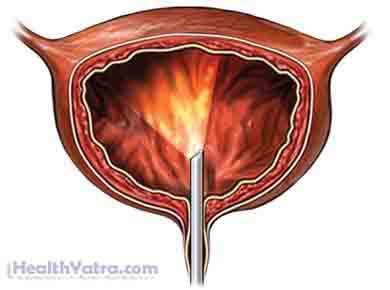Definition
A cystoscopy is a procedure to examine the bladder with a lighted scope. The scope allows the doctor to look through the urethra and into the bladder. The urethra is a tube that carries urine from the bladder to the outside of the body.

Reasons for Procedure
Cystoscopy may be done to investigate the following symptoms:
- Repeated urinary tract infections
- Blood in the urine
- Urinary incontinence
- Frequent urination
- Dribbling after urination
- Pain during urination
- Difficulty urinating
Some abnormalities can be diagnosed through cystoscopy, including:
- Tumors
- Bladder stones
- Inflammation
- Cysts
- Pouches on the bladder wall
- Ulcers on the bladder wall
- Polyps
- Narrowing of the urethra
- Enlargement of the prostate gland in men
Possible Complications
Problems from this procedure are rare, but all procedures have some risk. Your doctor will review potential problems. Complications may include:
- Infection
- Bleeding
- Rarely, accidental damage of the bladder wall with the cystoscope
Factors that may increase the risk of complications include:
- Smoking
- Active infection
- Diabetes
- Bleeding disorder
Talk to your doctor about these risks before the procedure.
What to Expect
Prior to Procedure
This procedure is usually done in your doctor’s office.
Anesthesia
Local anesthesia is used to numb the area in and around the urethra. A sedative may also be given to help you relax.
Description of the Procedure
You will lie on an exam table. The doctor will insert a cystoscope through the urinary opening, into the urethra, and into the bladder. Your bladder will be drained of urine. A sample will be kept for testing. Next, your bladder will be filled with sterile water or saline solution. This will allow a better view of the bladder walls. The bladder, and urethra will be examined.
How Long Will It Take?
Up to 15 minutes
How Much Will It Hurt?
Local anesthesia will keep you free from pain. You may feel some discomfort or urge to urinate when the bladder is filled during the exam.
Post-procedure Care
After the procedure, you may experience a burning sensation or see small amounts of blood when you urinate. To help with your recovery at home:
- Drink plenty of fluids as directed by your doctor for the first few hours after the procedure.
- Take any medication as prescribed by your doctor, including antibiotics if needed.
- Be sure to follow your doctor’s instructions.
Call Your Doctor
After arriving home, contact your doctor if any of the following occur:
- Frequency, urgency, burning, or pain when urinating
- You are unable to urinate or empty your bladder completely
- Blood in your urine after 24 hours
- Signs of infection; including fever and chills
- Pain in your abdomen, back, or side
In case of an emergency, call for medical help right away.
